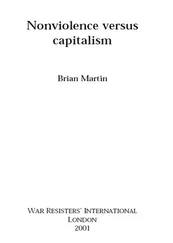Nonviolent action is also effective in winning the loyalty of soldiers on the other side. If they are opposed only by nonviolent methods, they are less likely to be willing to obey orders to beat or kill. The fear of being killed themselves is largely removed, and the justification for killing is greatly weakened. Many Israeli soldiers were repelled by their commanders’ orders or expectations that they beat unarmed resisters. Another example occurred in 1986 in the Philippines during the popular nonviolent resistance to the Marcos dictatorship, in what was called “people power.” Hundreds of thousands of people lined the street in protest. Soldiers refused to fire on the demonstrators. A small contingent of troops declared their loyalty to the popularly elected president Cory Aquino. These troops were “defended” by massive numbers of nonviolent demonstrators in the surrounding streets. Pilots sent to bomb the rebel soldiers did not carry out their mission for fear of harming the nearby civilians.
Nonviolent action thus can be effective in winning the loyalty of two key groups: the participants or potential participants in the nonviolent struggle and the soldiers on the other side. It is also effective in winning the loyalty of a third group: people elsewhere in the world, especially those in the country deploying the troops against an unarmed population. Killing of unarmed civilians is a cause for outrage; military action against a population using only nonviolent methods is likely to stimulate the creation of an opposition movement. The intifada quickly won the sympathy of people around the world for the plight of the Palestinians, something that years of terrorist activity by the PLO had never achieved. The massacre of civilians at Sharpeville in South Africa in 1960 generated enormous opposition to apartheid throughout the world. By contrast, killings of far more people in the course of guerrilla warfare seldom lead to any attention or concern at all.
There are numerous historical examples of the use of nonviolent action, some of which are mentioned in later chapters. [11] . Numerous examples are given in Gene Sharp, The Politics of Nonviolent Action (Boston: Porter Sargent, 1973), the classic source in the field. See also Jacques Semelin, Unarmed against Hitler: Civilian Resistance in Europe, 1939-1943 (Westport, CT: Praeger, 1993).
For the purposes here, it is only necessary to note that nonviolent struggle is a possible alternative to armed struggle. Rather than using violence to subjugate or destroy the enemy, nonviolent struggle works by building the will to resist and by undermining the will of the opponent.
Nonviolent methods are widely used in social struggles. One famous example is the civil rights movement in the United States, led by Martin Luther King, Jr. Campaigns by environmentalists, feminists and many others are almost entirely nonviolent, though sometimes violence is used against them.
It is possible to imagine organised nonviolent action as an alternative to military defence. When a community makes systematic plans and preparations to use nonviolent action to defend itself against aggression or repression, this can be called social defence, nonviolent defence, civilian defence, civilian-based defence or defence by civil resistance. [12] . Anders Boserup and Andrew Mack, War Without Weapons: Non-violence in National Defence (London: Frances Pinter, 1974); Burrowes, op. cit.; Theodor Ebert, Gewaltfreier Aufstand: Alternative zum Bürgerkrieg [Nonviolent Insurrection: Alternative to Civil War] (Freiburg: Rombach, 1968); Gustaaf Geeraerts (editor), Possibilities of Civilian Defence in Western Europe (Amsterdam: Swets and Zeitlinger, 1977); Stephen King-Hall, Defence in the Nuclear Age (London: Victor Gollancz, 1958); Bradford Lyttle, National Defense Thru Nonviolent Resistance (Chicago, IL: Shahn-ti Sena, 1958); Brian Martin, Social Defence, Social Change (London: Freedom Press, 1993); Michael Randle, Civil Resistance (London: Fontana, 1994); Adam Roberts (editor), The Strategy of Civilian Defence: Non-violent Resistance to Aggression (London: Faber and Faber, 1967); Gene Sharp, Making Europe Unconquerable: The Potential of Civilian-based Deterrence and Defense (Cambridge, Mass.: Ballinger, 1985); Gene Sharp with the assistance of Bruce Jenkins, Civilian-Based Defense: A Post-Military Weapons System (Princeton: Princeton University Press, 1990); Franklin Zahn, Alternative to the Pentagon: Nonviolent Methods of Defending a Nation (Nyack, NY: Fellowship Publications, 1996).
Social defence can be considered to be a special application of nonviolent struggle, namely to defend a community against military aggression or repression. The community could be a town, an ethnic group, a country or a transnational organisation.
In reality, no sizeable community has ever introduced social defence, so discussions about how it would operate are based on what is known about actual nonviolent struggles. There are some important differences in the way that nonviolent defence is conceived. Some see it as a functional replacement for military defence, focussing on national defence, with the rest of society pretty much unchanged. This orientation is often associated with the name civilian-based defence. [13] . Gene Sharp is the most prominent advocate of this perspective.
A different orientation, indeed almost a different definition, sees social defence as virtually any form of nonviolent action against governments, and aims at major social change through nonviolence. This orientation is adopted by many grassroots activists.
My preference is to define social defence as an alternative to military defence, but not restrict “defence” to defence of the state. Rather, defence of “community” is the key, leaving considerable ambiguity in the term community. This is compatible with the grassroots orientation to social change but retains an emphasis on defence against military aggression and repression.
Whatever the definition, there are some important differences between military defence and social defence, as suggested by the following table.
|
Military defence |
Social defence |
| Means of struggle |
Violent action |
Nonviolent action |
| Participants |
Mostly professional soldiers, especially young fit men |
Potentially everyone |
| Thing defended |
The state; ruling class |
Community; a way of life |
| Method of organisation |
Bureaucracy; chain of command |
Network, consensus and/or bureaucracy |
| Characteristic technologies |
Weapons |
Network communication and community self-reliance |
Why Use Nonviolent Methods?
For those who do not have armies or sophisticated weapons, nonviolence is likely to be more effective than violence. [14] . Nonviolence can also be more effective than violence for those who do have armies. Many of the points below apply.
Groups that oppose a military dictatorship, for example, have no chance of matching the firepower of the state. Militaries have planes, tanks, missiles and advanced surveillance technologies. Guerrilla opponents often have little more than guns, and also usually far fewer soldiers.
Technological developments have increased the military advantage held by governments over opponents. In a direct military confrontation, guerrillas will almost always lose. Their only chance is to use political means to win popular support and undermine the cohesiveness of the ruling group. Guerrilla warfare is in practice mainly a form of political struggle with precisely this aim. Guerrillas can win support by promoting land reform, opposing exploitation by local elites, carrying out labour to help the people, and by being honest and frugal rather than corrupt.
Читать дальше












